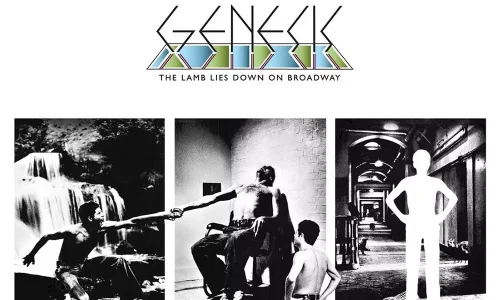When Genesis released The Lamb Lies Down on Broadway in 1974, it marked both a culmination and a turning point in the band’s career. Known for their elaborate and theatrical approach to progressive rock, Genesis had already established a reputation for blending intricate musicianship with vivid storytelling. But this album—an ambitious double LP—represented a bold leap into uncharted territory, both sonically and conceptually.
Set against the backdrop of mid-1970s rock, where grandiose concepts and epic storytelling were gaining traction, The Lamb Lies Down on Broadway emerged as a defining moment in the genre. Unlike their earlier works, which often drew on pastoral English themes and fantasy, this album ventured into darker, more urban terrain. It was a narrative-heavy piece, a rock opera of sorts, chronicling the surreal journey of Rael, a Puerto Rican street kid navigating a bizarre and often nightmarish world.
Artistic Intentions
The album’s creation was driven by the artistic ambitions of frontman Peter Gabriel, who wrote the majority of the lyrics and conceived the story. This shift in creative dynamics marked a departure from the more collaborative songwriting process that had defined Genesis’s earlier albums. Gabriel’s vision was clear: he wanted to push the boundaries of what rock music could be, both in terms of storytelling and theatricality. The result was a dense, enigmatic work that demanded—and rewarded—close listening.
The Lamb Lies Down on Broadway was a departure not only in terms of theme but also in sound. While still rooted in the complex arrangements and virtuosic playing that defined progressive rock, the album embraced a more diverse sonic palette. It incorporated elements of American soul, avant-garde experimentation, and a harder-edged rock sound, reflecting the grittiness of its urban narrative. This mix of influences was unusual for Genesis, and it showcased their willingness to evolve and challenge their audience.
In many ways, The Lamb Lies Down on Broadway can be seen as both a deepening of Genesis’s existing themes—such as the exploration of identity, myth, and the human condition—and a radical departure that set the stage for the band’s future evolution. As their last album with Gabriel, it also marked the end of an era, capturing a moment when the band was both at the height of its powers and on the brink of significant change.
Sonic Exploration

The sonic landscape of The Lamb Lies Down on Broadway is as intricate and multi-layered as the story it tells. Produced by John Burns and Genesis themselves, the album’s production quality reflects a meticulous attention to detail that enhances the album’s thematic depth. The sound is crisp and clear, capturing the full range of the band’s instrumental prowess while also allowing for the subtleties of Peter Gabriel’s storytelling to shine through. Despite the clarity, there’s a deliberate complexity to the mix that mirrors the labyrinthine journey of Rael, the album’s protagonist.
Musical Arrangements
One of the most striking aspects of the album is its diverse and ambitious musical arrangements. Genesis had always been known for their elaborate compositions, but on The Lamb Lies Down on Broadway, they pushed their creativity to new heights. The album features a rich tapestry of sound, with Tony Banks’ keyboards often taking center stage. Banks’ use of synthesizers, Mellotron, and piano provides a dynamic and sometimes eerie backdrop that shifts seamlessly between the album’s many moods, from the frenetic energy of the title track to the haunting atmospherics of “The Waiting Room.”
The rhythm section, anchored by Mike Rutherford’s bass and Phil Collins’ drums, plays a crucial role in grounding the album’s more fantastical elements. Collins’ drumming, in particular, showcases a versatility that ranges from precise, almost machine-like patterns to loose, jazz-inspired grooves. His percussive creativity adds a layer of tension and unpredictability that complements the album’s surreal narrative. Rutherford’s bass lines, often in lockstep with Steve Hackett’s guitar, are equally dynamic, providing both rhythmic foundation and melodic counterpoint.
Hackett’s guitar work on the album is another highlight. Known for his innovative use of tapping and sweeping arpeggios, Hackett’s contributions range from delicate, almost classical passages to searing, distorted solos that add to the album’s darker, more aggressive moments. His guitar is both a vehicle for melody and a tool for creating texture, often blending into the overall soundscape rather than standing out as a traditional lead instrument.
Genre Elements
In terms of genre, The Lamb Lies Down on Broadway is rooted in progressive rock but ventures far beyond the boundaries of the genre. The album incorporates elements of soul, particularly in its rhythmic structures and vocal delivery. Tracks like “The Carpet Crawlers” and “The Lamia” have a melodic sensitivity that hints at a broader pop sensibility, while the raw energy of songs like “Back in N.Y.C.” and “The Colony of Slippermen” flirt with proto-punk intensity.
What truly sets the album apart is its genre-blending approach. The band integrates these diverse influences into a cohesive whole that feels both innovative and purposeful. The shifts in style are not just for show; they reflect the changes in Rael’s journey, with the music adapting to the narrative’s twists and turns. This synthesis of styles, combined with the album’s adventurous production and intricate arrangements, makes The Lamb Lies Down on Broadway not only a milestone in Genesis’s discography but also a landmark in the broader landscape of 1970s rock.
Lyrical Analysis

At the heart of The Lamb Lies Down on Broadway lies a narrative rich with symbolism, surrealism, and existential questioning. The album’s central themes revolve around identity, transformation, and the struggle between the spiritual and the material worlds. These themes are intricately woven into the lyrics, which were penned primarily by Peter Gabriel, who crafted a story that is as enigmatic as it is compelling.
The album follows the journey of Rael, a young Puerto Rican man navigating a series of bizarre and often nightmarish experiences in a quest for self-discovery and redemption. This narrative framework allows Gabriel to explore a wide array of themes, including the search for identity in a fragmented world, the tension between reality and illusion, and the confrontation of one’s inner demons. The album’s recurring motifs—such as the lamb, which symbolizes innocence and sacrifice, and the slippermen, grotesque figures representing the dehumanizing effects of societal pressures—serve as anchors in the otherwise shifting, dream-like narrative.
Lyrical Depth
Gabriel’s lyrics are dense with meaning, often straddling the line between the straightforward and the abstract. At times, the story is told in a clear, almost cinematic way, as in the opening title track, where Rael’s descent into the strange underworld is vividly described. Lines like “The lamb lies down on Broadway / Early morning Manhattan, Ocean winds blow on the land” immediately set the scene, grounding the listener in a specific place and time. However, as the album progresses, the lyrics become more cryptic and open to interpretation. Songs like “In the Cage” and “The Chamber of 32 Doors” delve into Rael’s psychological turmoil, using imagery that is surreal and often disorienting, reflecting his inner chaos.
The lyrical complexity of The Lamb Lies Down on Broadway is a key part of its appeal. Gabriel employs a variety of literary techniques, including allegory, metaphor, and wordplay, to create a text that is both rich in detail and broad in scope. This lyrical depth invites multiple interpretations, with listeners able to find new meanings with each listen. Whether viewed as a critique of modern society, a spiritual allegory, or a personal odyssey, the album’s lyrics resonate on multiple levels.
Emotional Impact
Emotionally, the lyrics of The Lamb Lies Down on Broadway are powerful and multifaceted. They evoke a wide range of feelings, from the anxiety and claustrophobia of “In the Cage” to the poignant beauty of “The Carpet Crawlers.” Gabriel’s ability to convey both the external journey and the internal struggles of Rael gives the album a profound emotional weight. The lyrics often reflect a deep sense of alienation and longing, but they are also infused with moments of hope and transcendence.
The emotional impact of the lyrics is further heightened by Gabriel’s vocal delivery. His voice carries the weight of Rael’s experiences, shifting from anger and defiance to vulnerability and introspection. This vocal performance, combined with the lyrical content, creates a powerful connection with the listener, drawing them into Rael’s world and making his journey feel both personal and universal.
Cohesion and Flow

One of the most remarkable aspects of The Lamb Lies Down on Broadway is its ability to maintain a sense of cohesion and flow across its ambitious, sprawling double album format. The tracks are meticulously sequenced to support the narrative arc, ensuring that the listener is fully immersed in Rael’s surreal journey from beginning to end. This careful arrangement of songs enhances the album’s narrative progression and emotional impact, making it not just a collection of tracks, but a unified work of art.
The album opens with the title track, a burst of energy that sets the stage for Rael’s descent into the strange world beneath New York City. This track seamlessly flows into “Fly on a Windshield,” where the music takes on a more ominous tone, reflecting the shift from the familiar to the uncanny. As the album progresses, each track transitions smoothly into the next, often using musical motifs and recurring themes to create a sense of continuity. For instance, the eerie soundscape of “The Waiting Room” builds tension that is released in the frenetic “Anyway,” mirroring the unpredictable twists and turns of Rael’s journey.
This sense of flow is not just musical but also emotional. The album expertly balances moments of intensity with more reflective passages, guiding the listener through a rollercoaster of emotions. Tracks like “In the Cage” and “The Chamber of 32 Doors” explore Rael’s feelings of entrapment and confusion, while songs like “The Carpet Crawlers” and “The Lamia” offer moments of introspection and beauty. This emotional progression mirrors Rael’s internal struggles, making the album’s narrative arc feel both compelling and natural.
Thematic Consistency
Thematic consistency is another key factor in the album’s cohesion. Despite the diversity of musical styles and the complexity of the narrative, The Lamb Lies Down on Broadway maintains a strong thematic unity throughout. The recurring motifs of identity, transformation, and the duality of human experience are woven into every track, ensuring that even the most experimental or disparate elements feel like they belong to the same story. The use of symbolic imagery—such as the lamb, the cage, and the slippermen—reinforces these themes, creating a rich tapestry of interconnected ideas.
While the album does explore a wide range of musical styles, from the aggressive rock of “Back in N.Y.C.” to the delicate, almost ethereal quality of “The Carpet Crawlers,” these shifts in style never feel jarring. Instead, they reflect the album’s narrative shifts, with the music adapting to the changing scenes and emotions of Rael’s journey. This ability to blend different genres and moods while maintaining a cohesive overall sound is a testament to the band’s skill and vision.
There are moments, particularly in the second half of the album, where the narrative becomes more abstract and the music more experimental. However, these moments serve to deepen the album’s themes rather than detract from its cohesion. Even when the story veers into surreal territory, the underlying emotional and thematic threads remain intact, keeping the listener engaged and connected to Rael’s journey.
Standout Tracks and Moments
Within the vast and complex landscape of The Lamb Lies Down on Broadway, several tracks stand out for their artistic brilliance, emotional resonance, and innovative approaches. These tracks not only serve as high points within the album but also encapsulate the essence of Genesis’s creative vision during this period.
“The Lamb Lies Down on Broadway”
As the album’s opening track, “The Lamb Lies Down on Broadway” is both a statement of intent and a powerful introduction to the world of Rael. The song’s driving piano riff, accompanied by Peter Gabriel’s commanding vocals, immediately draws the listener into the story. Its energetic pace and memorable melody make it one of the most accessible and enduring tracks on the album.
The lyrics, filled with imagery of New York City and references to popular culture, establish the urban setting and the sense of urgency that permeates the album. This track stands out not only for its role in setting the scene but also for its ability to encapsulate the duality of the album’s themes—combining the familiar with the surreal.
“In the Cage”
“In the Cage” is a tour de force that exemplifies Genesis’s ability to blend complex musicianship with emotional depth. The track captures Rael’s sense of entrapment and claustrophobia as he finds himself confined in a mysterious cage. Tony Banks’ rapid-fire keyboard arpeggios create an intense, almost frantic atmosphere, while Phil Collins’ drumming drives the song forward with relentless precision.
Gabriel’s vocal delivery, filled with desperation and anxiety, brings the character’s internal turmoil to life. The song’s intricate structure, with its shifting time signatures and dynamic changes, showcases Genesis at the height of their progressive rock prowess. “In the Cage” is a standout not only for its technical brilliance but also for its ability to convey the psychological depths of Rael’s journey.
“The Carpet Crawlers”
“The Carpet Crawlers” is one of the album’s most hauntingly beautiful moments. The track’s gentle, almost hypnotic melody contrasts with the more intense and chaotic songs that surround it, offering a moment of introspection and calm. Gabriel’s lyrics, filled with evocative and mysterious imagery, describe a group of beings—possibly souls—struggling to ascend to a higher plane.
The line “You’ve got to get in to get out” is one of the album’s most memorable, capturing the paradoxical nature of Rael’s quest. Musically, the song is anchored by Tony Banks’ lush keyboard chords and the subtle interplay between Mike Rutherford’s bass and Steve Hackett’s delicate guitar work. “The Carpet Crawlers” stands out for its emotional impact, serving as a moment of reflection and spiritual yearning within the larger narrative.
“The Lamia”
“The Lamia” is a track that combines lyrical beauty with musical sophistication. In this song, Rael encounters three seductive, serpent-like creatures, and the encounter is described with a mix of eroticism and tragedy. Gabriel’s vocals are at their most tender and expressive, capturing the allure and sorrow of the Lamia’s fate. The song’s arrangement is lush and atmospheric, with Hackett’s guitar and Banks’ keyboards creating a dreamlike soundscape that enhances the story’s mythological overtones. The track is a standout for its lyrical and musical elegance, blending elements of classical music with the band’s signature progressive rock sound.
“Back in N.Y.C.”
“Back in N.Y.C.” is a raw and aggressive track that showcases the band’s willingness to experiment with a harder-edged sound. The song’s driving bassline and distorted guitar riffs give it a proto-punk energy that contrasts sharply with the more refined compositions elsewhere on the album. Gabriel’s lyrics, delivered with a snarl, reflect Rael’s rebellious and defiant nature as he confronts his past in New York City. The track’s intensity and raw power make it a standout moment that highlights the album’s thematic exploration of identity and alienation.
Memorable Moments
Throughout the album, there are specific moments that capture its essence and showcase the band’s talent. One such moment is the instrumental passage in “The Waiting Room,” where the band delves into avant-garde territory with an improvised sound collage that evokes a sense of impending chaos. The eerie, atmospheric build-up leads to a sudden explosion of sound, reflecting Rael’s unpredictable journey through a nightmarish landscape.
Another memorable moment is the climactic instrumental section of “The Colony of Slippermen,” where Genesis combines complex time signatures, dissonant chords, and surreal lyrics to create a disorienting and unsettling atmosphere. This section encapsulates the album’s blend of the bizarre and the sublime, pushing the boundaries of what rock music can achieve.
Finally, the album’s closing track, “It,” delivers a powerful conclusion to Rael’s odyssey. The repetitive, mantra-like refrain “It is real, it is Rael” brings the story full circle, leaving listeners with a sense of ambiguity and contemplation. The track’s driving rhythm and infectious melody ensure that the album ends on a high note, leaving a lasting impression.
Artistic Contribution and Innovation
The Lamb Lies Down on Broadway occupies a singular place within the progressive rock genre and the broader music industry of the 1970s. At a time when concept albums and rock operas were becoming increasingly popular, Genesis managed to push the boundaries of what was possible within these formats, creating a work that was both thematically ambitious and musically groundbreaking. The album’s scope, complexity, and depth not only set it apart from its contemporaries but also solidified Genesis’s reputation as one of the leading innovators in progressive rock.
Within the genre, The Lamb Lies Down on Broadway stands as a benchmark for concept albums. While many bands of the era were experimenting with long-form storytelling and thematic coherence, Genesis took these ideas to their logical extreme by crafting an entire double album around a single, intricate narrative. This was no small feat, especially considering the genre’s tendency toward sprawling, sometimes disjointed compositions. The band’s ability to maintain a cohesive story across 23 tracks without sacrificing musical diversity is a testament to their artistic vision and discipline.
Innovation
In terms of innovation, The Lamb Lies Down on Broadway broke new ground in several key areas. First, the album’s narrative approach was both daring and unconventional. Unlike many concept albums that relied on abstract or mythological themes, Genesis grounded their story in the gritty reality of 1970s New York City, while simultaneously delving into surreal and symbolic territory. This juxtaposition of the real and the fantastical was innovative, challenging the listener to engage with the album on multiple levels—both as a piece of fiction and as an exploration of deeper philosophical and psychological themes.
Musical Elements
Musically, the album is a showcase of Genesis’s ability to blend diverse influences into a cohesive whole. While firmly rooted in the progressive rock tradition, The Lamb Lies Down on Broadway incorporates elements of soul, proto-punk, classical music, and avant-garde experimentation. The band’s willingness to integrate these disparate styles into their sound was innovative and ahead of its time, reflecting a broader trend in the music industry toward genre-blending that would become more prominent in the decades to follow.
Production
The album’s production also contributed to its status as a groundbreaking work. John Burns and Genesis crafted a sound that was both polished and richly textured, yet capable of conveying the raw emotion and surreal atmosphere required by the story. The use of layered keyboards, complex time signatures, and unconventional song structures was innovative, pushing the technical boundaries of what could be achieved in a rock album. The production quality was crisp and clear, allowing the album’s intricate arrangements and nuanced performances to shine through, while still maintaining a sense of mystery and depth.
Themes
Thematically, The Lamb Lies Down on Broadway was innovative in its exploration of identity, reality, and the human psyche. These themes were not new to rock music, but the way Genesis approached them—through the lens of a surreal, character-driven narrative—was unique. The album’s story of Rael’s journey through a strange, fragmented world can be seen as a metaphor for the human condition, grappling with the complexities of modern life, self-discovery, and transformation. This thematic depth, combined with the album’s rich symbolism and allegory, pushed the boundaries of what a rock album could achieve in terms of storytelling and intellectual engagement.
Place in Music Industry
In the broader context of the music industry, The Lamb Lies Down on Broadway was a bold statement at a time when the concept of the album as an art form was still evolving. It challenged the norms of commercial music by prioritizing artistic expression and narrative coherence over radio-friendly singles or commercial appeal. This approach influenced a generation of musicians and bands who sought to create albums that were not just collections of songs but cohesive, immersive experiences.
Closing Thoughts
The Lamb Lies Down on Broadway is a monumental achievement in the history of progressive rock and remains one of Genesis’s most ambitious and artistically daring works. The album’s strengths are numerous: from its intricate and cohesive narrative structure to its innovative blending of genres, and its ability to maintain thematic consistency across a sprawling double album. The meticulous production and sophisticated musical arrangements showcase the band’s technical prowess, while Peter Gabriel’s evocative lyrics and compelling vocal performances give the story of Rael a powerful emotional core.
Strengths & Weaknesses
One of the album’s greatest strengths is its ability to transport listeners into a vividly realized world that is at once strange and familiar, surreal yet grounded in real human emotions. This is a rare feat in rock music, and it underscores Genesis’s mastery of storytelling through sound. The album’s innovation, both in its narrative approach and its musical exploration, set it apart from its contemporaries and cemented its place as a landmark in the genre.
However, The Lamb Lies Down on Broadway is not without its challenges. The album’s dense and often cryptic lyrics, coupled with its complex musical structures, can make it a demanding listen. Its ambitious scope may be overwhelming for some listeners, particularly those who are not already fans of progressive rock or concept albums. The narrative can be difficult to follow, especially as it becomes more abstract in the second half of the album, and some may find the album’s length and complexity to be daunting.
Yet, these potential weaknesses are also part of what makes the album so compelling. The Lamb Lies Down on Broadway is not meant to be an easy, passive listening experience; it is an album that rewards deep engagement and repeated listens. Its challenges are part of its brilliance, inviting listeners to dive deeper into its layers of meaning and sound.
Place in Career
In the context of Genesis’s career, this album represents both a high point and a pivotal moment. It was the last album to feature Peter Gabriel as the band’s frontman, and it marked the end of an era for Genesis. Yet, it also set the stage for the band’s evolution into new musical territories, influencing the direction of their future work. For many fans and critics, The Lamb Lies Down on Broadway stands as a definitive statement of the band’s creative vision during their progressive rock peak.
Official Rating
Given its artistic innovation, emotional depth, and lasting impact, The Lamb Lies Down on Broadway deserves a perfect rating of 10 out of 10. It is a masterpiece that pushes the boundaries of what rock music can achieve, both as a form of storytelling and as an art form. This album is a testament to the power of music to explore complex themes and create immersive worlds, making it not only a highlight of Genesis’s discography but also a timeless classic in the pantheon of rock music.
